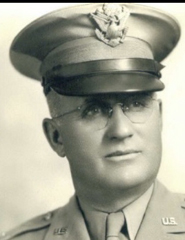FOLLOW LIBERATED PRISONER IN SEARCH FOR GERMAN GESTAPO
By Frank Miles
In the Field with the First Army (IDPA) -- A Russian, who had been a prisoner of the Germans since October of 1941, looked older than his true age. He had been liberated when American troops reached Weiden.
He had been denied a hair cut or shave in captivity, was wrinkled and underweight from meager rations and pack and mule work producing for the nazis. He had been beaten often by a burly Gestapo guard.
An American lieutenant and a group of war correspondents head his story told in broken English.
"I know where the Gestapo is," he said.
The lieutenant called for two MPS.
"Take this man out in a jeep and if he points out a German civilian bring the fellow in," the officer commanded.
As the heavily armed soldiers and the Russian started out, the lieutenant halted them.
"Take no chances on the guy," he said, " but don't shoot him or rough him up unless you have to."
"May I go along?" I asked.
"Sure" said the officer. "You realize of course you may get into a hot spot."
We drove at high speed to a house three miles distant. The MPs leaped out, one striding to the back door while the other with the Russian entered the front door. I bare-handed stood by the side of the vehicle so that I could duck if shots came from a window. My dreams of a story soon were blasted. The Gestapo was not there and from neighbors we learned he had departed.
From the Fifth army in North Italy I learned that when a house caught on fire from an overheated stove, Cpl. Joseph Ness, Des Moines, of the 168th leaped to safety from a third story window and landed unhurt.
Sgt. Roman G. Hazel, Le Mars, of the 133rd infantry, crawled nine hours on his stomach clearing a path through a dangerous minefield, which enabled a tank-supported infantry company to attack strategic Monte Belmonte. Hazel operated a mine detector and two other GIs with him detonated each mine found. The jerries poured mortar and machine gun bullets at them. The probing machine was knocked out by shell fragments before they reached the end of their route. The completed the job using trench knives as detectors. Hazel has the purple heart for wounds received in action and the combat infantryman badge. A brother, Francis Hazel, is an artilleryman in the Pacific.
Six more Iowans have been added to the 168th infantry which was originally composed almost wholly of former Iowa national guardsmen. They are Pvts. Melvin J. Mesch, Bernard; Harold W. Miller, Ankeny; Lawrence D. Moreland, Farmersburg; Ervin J. Wagner, Monroe; Staff Sgts. Clifford H. Broom, Williams, and Paul E. Anderson, Blakesburg.
Lieutenant Donald R. Schamp, Independence has been awarded the bronze star for heroic achievement in action, and 1st Sgt. Henry N. Byrd, Fort Madison, the bronze star for meritorious service in combat. Schamp is of the 19th combat engineer regiment of II corps and Byrd of the 757th tank battalion.
Cpl. Gene Hand, Corydon, en route home after 37 months overseas in the 34th quartermaster company of the 34th division.
Source: Carroll Daily Times Herald, April 26, 1945
![]()

